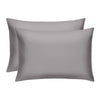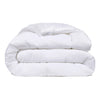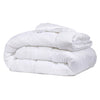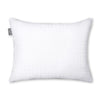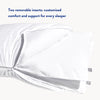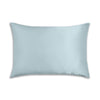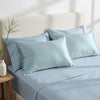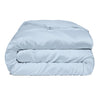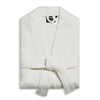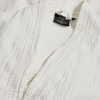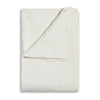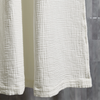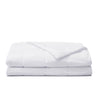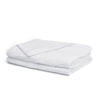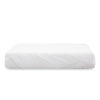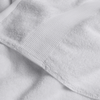The Daily Miracle
How To Get Mildew Smell Out of Towels
Published
August 07, 2023
Author
Suze Dowling
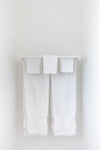
Drying off with a soft, plush towel after a soothing shower or bath is one of life's little pleasures. But what happens when that pleasure is interrupted by musty smelling towels? What's supposed to be a refreshing routine suddenly becomes an uncomfortable ordeal.
This often happens when your bath towels adopt the uninvited and stubborn guest known as mildew. How to get smell out of towels is a challenge most households grapple with, but the good news is, it's not an impossible task.
By understanding the causes and solutions to this pesky problem, you can learn how to remove mildew smell from towels for fresh towels every time.
So, you want to learn how to make towels smell fresh? Let’s dive in!
Understanding Mildew on Towels
Mildew is a type of fungus that is related to its more intrusive cousin, mold. While both thrive in damp environments, mildew primarily stays on the surface of materials, making it slightly easier to remove.
However, when mildew starts to build up on your towels, it releases gasses that get absorbed by the fabric and gives off a distinct damp, musky scent we associate with wet socks or a musty basement.
Your towels are a perfect breeding ground for mildew because they often stay damp for long periods, especially if they are not dried properly after use. Add a dash of poor air circulation — a common scenario in laundry baskets, unemptied washing machines, and even older bathrooms — and you've got your own science experiment brewing.
The way you wash your towels can also contribute to this problem. For instance, if you're washing your towels in cold water, you might not kill off the mildew and other bacteria effectively.
If you're using a front-loader washing machine, residue can accumulate in the gasket, leading to a buildup of mildew that can spread to your laundry. Overloading the washer can lead to insufficient cleaning and rinsing, leaving your towels still ripe for mildew growth.
Neglecting a mildew issue is not just unpleasant; it’s potentially unhealthy! Mildew can cause a variety of health problems, including a stuffy nose, sneezing, wheezing, and skin irritation. Therefore, learning how to get mildew smell out of towels isn't just a matter of olfactory aesthetics — it's also about maintaining a clean, healthy home environment.
In the next section, we'll walk you through getting mildew smell out of towels once and for all.
How To Get Moldy Smell Out of Towels
Lucky for all of us, learning how to get the smell out of towels isn’t exactly rocket science. But it does require just a bit of vigilance and adopting a few easy steps in your laundry routine.
Washing Towels
If you’re wondering how to make towels smell fresh, regular washing is the first step to ensuring your towels stay fresh and clean. If you're dealing with musty, stinky towels, a little extra attention is required.
- Choosing the right detergent: A high-quality laundry detergent can make a significant difference in getting smell out of towels. Our Laundry Detergent Sheets are the perfect alternative to your run-of-the-mill detergent. They’re deep-cleaning, so you know they’ll take care of mold and mildew, but at the same time, they’re great for your skin and the environment. So you can wash assured you’re doing your best to have towels that don’t smell every time.
- Adding vinegar or baking soda: If you’re into DIY solutions, both vinegar and baking soda are excellent natural solutions to help get mildew smell out of towels. They work as deodorizers that neutralize the pH balance of your towels, helping to eliminate odors. Simply add half a cup of baking soda or white vinegar to your regular detergent during the wash cycle.
- Using hot water: Washing your towels in hot water can be a lifesaver when it comes to getting the smell out of towels. Many modern washers have a sanitary or heavy-duty cycle meant to handle such items.
- Avoiding fabric softeners: Ironically, fabric softeners may make towels less absorbent over time and can leave a residue that contributes to a buildup of mildew. Instead, opt for a cup of white vinegar, which will help soften your towels without the residue.
Drying Towels After Use
While dryer sheets and essential oil may make your laundry smell fresh temporarily, it’s not enough to get rid of mildew. To achieve that clean towels smell, you’ll want to remove as much moisture as possible post-use minimizes the damp environment that mildew loves.
- Properly wringing out excess water: Before hanging a towel to dry, wring out any excess water. This reduces the towel's overall dampness, making it more challenging for mildew to develop.
- Air-drying: Weather permitting, hang your towels to air dry outside. Sunlight is a natural disinfectant and can help achieve those clean smelly towels. If outside isn't an option, ensure your bathroom is well-ventilated and has enough airflow to dry the towels thoroughly.
- Using a dryer: If you opt to use a dryer, don't overload it. Overcrowding prevents towels from drying thoroughly. Adding wool dryer balls can also enhance drying efficiency and help fluff your towels.
Storing Towels
Properly storing towels is another critical step in the quest for that clean towels smell.
- Ensure the towels are thoroughly dry before storing them to prevent mildew growth. Before you throw all of your towels — washcloths, hand towels, bath sheets, and more — into the wash together, think about space when drying them, especially when it comes to towel size. If you want towels that dont smell, you might want to hold off on washing all your bath towels at once if there’s nowhere to hang them!
- Store towels in a cool, dry, and well-ventilated area. If you must keep them in the bathroom, make sure it is well-ventilated and doesn't remain humid for extended periods. If you know your bathroom tends to get damp and humid, switch out your towels more frequently.
Are there towels that don't smell?
You might wonder if there are towels that inherently resist that unpleasant musty smell. The answer is yes! Our Miracle Made® Towels are infused with natural silver.
Because silver has antimicrobial powers, these towels fight bacteria and fungi, reducing the need for constant washing and getting mildew smell out of towels. In addition, their high absorbency and quick-drying nature make them a fantastic option to enhance your bathing experience, all while the silver prevents up to 99.7% of bacterial growth.
This means not just fewer odors and a more luxurious overall experience — but also that you can do the laundry up to 3x less, so these towels can improve your day in more ways than you’ve ever thought possible.
How To Make Towels Smell Fresh, Every Time
We've explored several tips on how to get rid of mildew smell in towels, from rethinking your detergent to being a little more vigilant about your laundry process. Ultimately, it all basically boils down to avoiding letting your linens sit around when they’re still damp and prioritizing ventilation. But most importantly, investing in innovative products like our naturally antimicrobial bath towels can also limit your struggle with must or mold, and give you those clean smelly towels we all love.
With these tips, you can transform your laundry room into a haven of fresh linens and say goodbye to the unpleasant mildew smell that once haunted your bath towels. Say goodbye to musty, damp towels and hello to the invigorating scent of cleanliness!
Sources:
What is the Difference Between Mold and Mildew? | EPA
Basic Facts About Mold and Dampness | CDC
Mold and Your Health | National Institute of Environmental Health Sciences
Household Alternatives - In the Kitchen | Department of Energy & Environmental Protection


